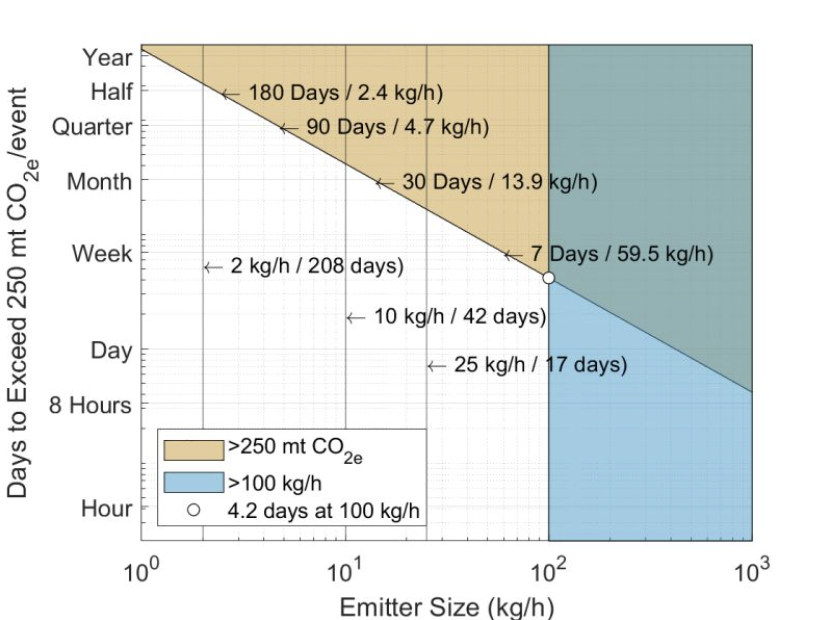.png)
Regulatory update: Revisions to EPA’s Subpart W reporting requirements for petroleum and natural gas systems
Name of regulation: Greenhouse Gas Reporting Rule: Revisions and Confidentiality Determinations for Petroleum and Natural Gas Systems
Stage: Proposed rule
Agency: U.S. Environmental Protection Agency (EPA)
On June 30, 2023, the EPA proposed updates to the GHG reporting requirements for petroleum and natural gas systems under 40 CFR part 98, subpart W. These proposed amendments consist of four parts: (1) revisions addressing potential gaps such as requiring reporting for sources in additional segments; (2) adds new calculation methodologies or improvements to existing methodologies to account for empirical data; (3) improvements to verification and transparency of collected data; and (4) other technical amendments, clarifications, and corrections.
How will the proposed updates to GHG reporting requirements impact overall reported emissions for operators?
The total emissions reported by an operator are likely to increase from previous reporting years. Starting with the 2025 reporting year, facilities will be required to report methane emissions from more sources than previously reported (Table 1). Additionally, the calculation methodology of several sources includes several proposed revisions (Table 2) that the EPA states take into account more recent measurement studies, but the general outcome is an overall increase as these revisions would result in higher emission factors than the current defaults.
Table 1: Newly added emissions sources for reporting:
|
Emission Source |
Segments to Report |
Pollutant |
|
Nitrogen removal units |
Production, Processing, Gathering & Boosting, LNG storage, LNG import/export |
CH4 |
|
Produced water tanks |
Production, Gathering & Boosting, Processing |
CH4 |
|
Drilling mud degassing |
Production |
CH4 (soliciting comment on including CO2) |
|
Crankcase venting from RICE or gas turbines |
Production, Processing, Transmission compression, Underground storage, LNG storage, LNG import/export, Gas distribution, Gathering & Boosting |
CH4 |
|
Other large-release events |
All segments |
CH4 |
Table 2: Revisions to existing emissions sources
|
Emission Source |
Sample of Proposed Revisions to Methodology |
New Segments Proposed |
Pollutants |
|
Blowdown vent stacks |
Clarifications regarding which requirements are applicable to each blowdown |
Production, Underground storage, LNG storage, Gas distribution |
CH4, CO2 |
|
Natural gas pneumatic device venting |
Direct measurement via flow meter on gas supply line Measurement of vented emissions Surveys for intermittent controllers, plus updated default factors If routed to control - reporting as part of total emissions for that control |
Processing, Gas distribution |
CH4, CO2 |
|
Natural gas pneumatic pump venting |
Direct measurement via flow meter on gas supply line Measurement of vented emissions If routed to control - reporting as part of total emissions for that control |
No new segments proposed |
CH4, CO2 |
|
Hydrocarbon liquids and produced water storage tanks |
Clarifications on inclusion of emissions from open thief hatches, including methodology to determine the reduced capture efficiencies when a thief hatch is open/not seated properly Revisions to equation W-16 to address malfunctioning dump valves Clarifications to identify applicable calculation methodology |
Processing |
CH4, CO2, N2O |
|
Dehydrator vents |
Allow use of either calculation method 1 or 2 for dehydrators with annual average daily throughput <0.4 MMscf/day Revisions for controlled vents to calculate emissions vented to atmosphere when not routed to control |
Transmission compression, Underground storage |
CO2, CH4 |
|
Condensate storage tanks |
Same as hydrocarbon liquids and produced water storage tanks |
Underground storage |
CH4, CO2, N2O |
|
Acid gas removal vents |
Adding reporting of CH4 emissions Calculation method 1 is not appropriate for CH4 reporting, but existing methods 2-4 are revised to include CH4 |
LNG storage, LNG import/export |
CO2, CH4 |
|
Equipment leaks (general) |
Updated leaker factors for OGI and Method 21 surveys Added “undetected” leaker factor to account for leaks that are missed Direct measurement through bagging or high-volume sampler Removal of Method 21 screening surveys and requiring reporting of all OGI leaks found Updated population-based factors for major equipment types |
No new segments proposed |
CH4, CO2 |
|
Equipment leaks at transmission company interconnect metering-regulating stations |
Use of default factors only |
Gas transmission pipeline |
CH4, CO2 |
|
Equipment leaks at farm tap and/or direct sale metering-regulating stations |
Use of default factors only |
Gas transmission pipeline |
CH4, CO2 |
|
Transmission pipeline equipment leaks |
Use of default factors only |
Gas transmission pipeline |
CH4, CO2 |
|
Liquids unloading |
Requirement to calculate emissions from unloadings for each well at least once every 3 consecutive calendar years (methods 2 and 3), or more frequently (method 1) |
Production |
CH4, CO2 |
|
Gas well completions and workovers with hydraulic fracturing |
Removing the option to use calculation method 2 (the Choke Flow equation) when using equation W-10A |
Production |
CH4, CO2, N2O |
Are the updates designed to promote the use of measured emissions?
For some sources, yes. There are options that would allow for use of measured emissions for purposes of reporting. Two specific examples are natural gas pneumatic device/pneumatic pump venting and equipment leaks. For pneumatic devices and vents, direct measurements would be required for calculating emissions if a flow meter is installed on the natural gas flow line to the device/pump. Where no flow meter is present, operators may choose to measure the emissions directly from the device/pump.
For equipment leaks, operators would have the option to measure every leak identified during a leak survey in order to report emissions. Alternatively, site-specific emission factors could be developed or facilities could use updated leak factors for OGI and Method 21 monitoring. Note: These emission factors are larger than those currently in Subpart W and are different from those proposed in 2022. While EPA did propose to incorporate alternative technologies for the purposes of detection in the NSPS OOOOb rulemaking, this proposed rule does not specifically allow for the use of alternative measurement/detection methods. However, EPA is soliciting comments on how measurements of leaks from those methods (e.g., continuous sensors, flyovers, satellites) could be incorporated in future revisions to Subpart W.
Historically, these two emission sources have had a lot of scrutiny, specifically related to the representativeness of the default emission factors. EPA’s proposal uses studies from the academic community to update factors, but uncertainty would remain regarding the accuracy of the factors derived from those studies. The addition of direct measurement should allow for future updates to default factors as EPA will have more measurement-based information available.
What is the relationship between these updates and other regulatory measures, and how will they influence each other?
Subpart W methane emissions reporting will feed directly into the calculation of the waste emissions charge (“methane fee”). While this proposal addresses how emissions (and throughput) must be calculated, we have to wait for yet another proposal to address more specific questions related to how EPA will implement the methane fee. According to the Regulatory Agenda, EPA is targeting that proposal for October 2023.
Beyond the implications of the methane fee, this action will leave operators wondering how EPA will finalize the super-emitter response program in NSPS OOOOb and the Emission Guidelines for states to develop their state plans (OOOOc). EPA has proposed the addition of an “other large release events” emissions source in the proposal. This source is meant to account for abnormal emission events and planned maintenance activities that exceed a 100 kg/hr instantaneous emissions threshold or a 250 mtCO2e per event threshold. Dan Zimmerle at Colorado State University (CSU) posted the visualization below, which shows the relationship between these two thresholds and puts these emissions into context with inspection intervals.

Daniel Zimmerle (2023, July 13). Relationship between emissions thresholds. LinkedIn.
The instantaneous threshold is directly from EPA’s NSPS OOOOb super-emitter response program proposal. Any change in that final rule to the threshold would likely result in a similar change for Subpart W. Additionally, this proposal would allow third-party notifications to trigger a reporting requirement specific to those notifications. EPA’s OOOOb/c final rules are expected later this year.
Separate from the EPA regulations, the Pipeline and Hazardous Materials Safety Administration (PHMSA) has also proposed leak detection and repair requirements for pipelines. The Subpart W proposal expands some of the reporting related to pipeline leaks, including adding reporting requirements for equipment leaks from onshore natural gas transmission pipeline facilities. However, unlike equipment leaks at upstream facilities, EPA only proposes the use of default emission factors based on population counts.
Conclusion
EPA plans to issue a final rule with revisions to Subpart W by August 16, 2024. Those revisions would be effective on January 1, 2025, and must be used for calculating emissions starting with reporting year 2025. EPA does not speak to the impacts on reporting year 2024, yet the methane fee is set to start based on 2024 emissions. It’s highly likely that with the extensive changes EPA has proposed, emissions will be significantly different for the 2025 reporting year, which will make comparisons to previous reporting years difficult given the many revisions to calculation methodologies and additional emissions sources.
While we don’t see full incorporation of measurement information quantification in this proposal, the EPA has signaled it is exploring how standoff measurement data from emerging technologies should be incorporated going forward. Forecasting potential fees will involve ensuring that your facilities have a robust and auditable baseline inventory. Incorporation of operational parameters will also be vital to reporting of specific emissions sources, including the other large release events.
Tech & experts to help you navigate the evolving regulatory landscape.
Contact us to discover how the Validere platform and expert guidance can prepare your organization for changing regulations. With our scenario modeling capabilities and correlation of operational and emissions data, we can help you better monitor, track, and report your emissions profile.

Karen Marsh
Prior to Validere, Karen Marsh served as a senior environmental engineer and lead regulation developer for the U.S. EPA, authoring key regulations such as New Source Performance Standards for the oil and gas industry. Karen brings 15+ years of experience in developing regulations to reduce methane emissions, various LDAR regulations, fugitive emissions detection, air permitting, and GHG reporting.
